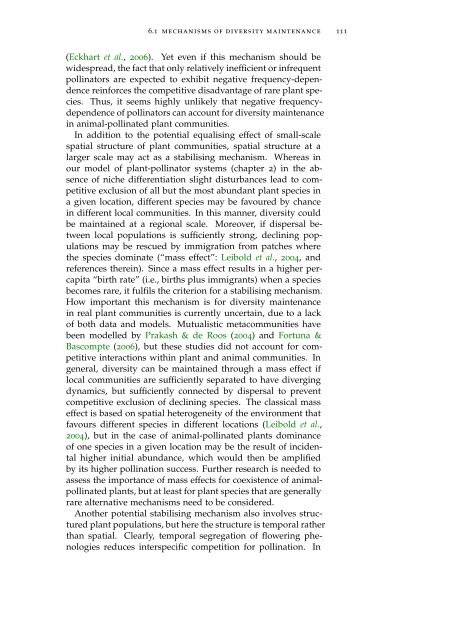Linking Specialisation and Stability of Plant ... - OPUS Würzburg
Linking Specialisation and Stability of Plant ... - OPUS Würzburg
Linking Specialisation and Stability of Plant ... - OPUS Würzburg
Create successful ePaper yourself
Turn your PDF publications into a flip-book with our unique Google optimized e-Paper software.
6.1 mechanisms <strong>of</strong> diversity maintenance 111<br />
(Eckhart et al., 2006). Yet even if this mechanism should be<br />
widespread, the fact that only relatively inefficient or infrequent<br />
pollinators are expected to exhibit negative frequency-dependence<br />
reinforces the competitive disadvantage <strong>of</strong> rare plant species.<br />
Thus, it seems highly unlikely that negative frequencydependence<br />
<strong>of</strong> pollinators can account for diversity maintenance<br />
in animal-pollinated plant communities.<br />
In addition to the potential equalising effect <strong>of</strong> small-scale<br />
spatial structure <strong>of</strong> plant communities, spatial structure at a<br />
larger scale may act as a stabilising mechanism. Whereas in<br />
our model <strong>of</strong> plant-pollinator systems (chapter 2) in the absence<br />
<strong>of</strong> niche differentiation slight disturbances lead to competitive<br />
exclusion <strong>of</strong> all but the most abundant plant species in<br />
a given location, different species may be favoured by chance<br />
in different local communities. In this manner, diversity could<br />
be maintained at a regional scale. Moreover, if dispersal between<br />
local populations is sufficiently strong, declining populations<br />
may be rescued by immigration from patches where<br />
the species dominate (“mass effect”: Leibold et al., 2004, <strong>and</strong><br />
references therein). Since a mass effect results in a higher percapita<br />
“birth rate” (i.e., births plus immigrants) when a species<br />
becomes rare, it fulfils the criterion for a stabilising mechanism.<br />
How important this mechanism is for diversity maintenance<br />
in real plant communities is currently uncertain, due to a lack<br />
<strong>of</strong> both data <strong>and</strong> models. Mutualistic metacommunities have<br />
been modelled by Prakash & de Roos (2004) <strong>and</strong> Fortuna &<br />
Bascompte (2006), but these studies did not account for competitive<br />
interactions within plant <strong>and</strong> animal communities. In<br />
general, diversity can be maintained through a mass effect if<br />
local communities are sufficiently separated to have diverging<br />
dynamics, but sufficiently connected by dispersal to prevent<br />
competitive exclusion <strong>of</strong> declining species. The classical mass<br />
effect is based on spatial heterogeneity <strong>of</strong> the environment that<br />
favours different species in different locations (Leibold et al.,<br />
2004), but in the case <strong>of</strong> animal-pollinated plants dominance<br />
<strong>of</strong> one species in a given location may be the result <strong>of</strong> incidental<br />
higher initial abundance, which would then be amplified<br />
by its higher pollination success. Further research is needed to<br />
assess the importance <strong>of</strong> mass effects for coexistence <strong>of</strong> animalpollinated<br />
plants, but at least for plant species that are generally<br />
rare alternative mechanisms need to be considered.<br />
Another potential stabilising mechanism also involves structured<br />
plant populations, but here the structure is temporal rather<br />
than spatial. Clearly, temporal segregation <strong>of</strong> flowering phenologies<br />
reduces interspecific competition for pollination. In
















